Meet the daring tree climbers needed to replant 1.5 million acres of California’s burnt forests
On an October day in Plumas National Forest, Alex Lemnah traverses the canopy of an incense cedar nearly 100 feet off the ground, listening carefully for the sound of a branch snapping under his feet.
His job is to climb California conifers — pines, firs, cedars and redwoods — to collect their cones. Inside these spiny reproductive globes are the real prize: seeds. But things can turn dicey when the wind picks up.
“There’s that balance point when I start to feel the whole tree leaning back, or even swaying. That’s when I know I can’t go much higher,” he said. “For this job, I go up pretty high.”
There are only a couple dozen of these intrepid climbers in the state, mostly living out of vans, cooking backcountry meals and sleeping under the stars. The full moon can make it difficult to sleep, and some may not have showered in a few days.
These climbers are also the linchpin in California’s new plan to save scorched forests from disappearing, threatened by mega-fires made worse by poor forest management and climate change.
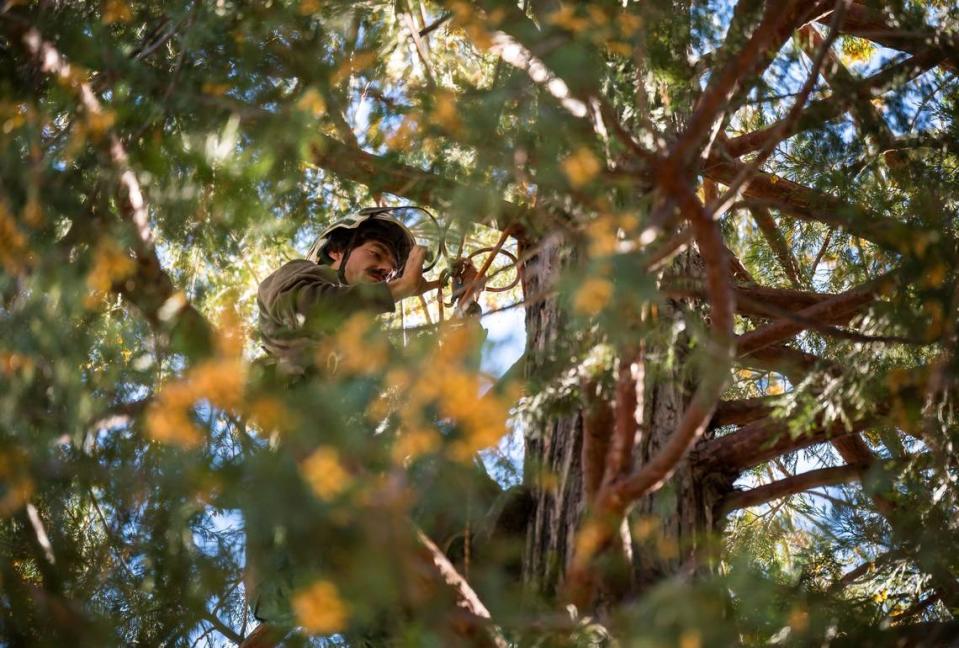
Gov. Gavin Newsom’s Forestry and Fire Task Force found that 1.5 million acres of California forest were scorched by 70% high-severity fire during the 2019-2021 fire seasons, according to an internal estimate shared with The Bee. Fire devastation on those acres is so intense that trees won’t naturally grow back, and to prevent them from becoming shrubby chaparral, they need to be replanted.
But reforestation at this scale is no small feat, mainly because the state lacks the capacity to get it done. Foresters say bringing back California’s “reforestation pipeline” — the network of seed banks, nurseries and planting operations — is desperately needed.
Meeting the state’s target would require around 300 million new trees and closer to 500 million conifer seeds, five times what was collected last year, according to calculations based on industry estimates. Tree planting costs alone would cost around $1.5 billion.
It’s also a race against the clock. Each year after a fire burns through an area, it becomes more costly and challenging to put trees back onto the landscape. So state and federal agencies, private industry and non-profit organizations are training a new generation of climbers to collect seeds.
Lemnah, 29, is exactly who they’re looking for. A former firefighter turned arborist that typically cuts down hazardous trees near power lines, conifers are practically in his bones. He grew up around the tree falling business in Quincy, and plays keyboard for a band called Lumbercat.
“I love the idea of climbing a tree but not permanently affecting the tree if possible. It’s just a nice change up,” he said, trudging with his equipment into his truck for a snack after a long climb. “It’s a little more strenuous, but it reminds me of picking blackberries... and having watched the Dixie fire scour my county, I really like the mission to replant in the burn print.”
‘Please come climb’
About 30 other people in California professionally climb trees to collect cones. Most travel thousands of miles for all of September, through October, and sometimes even November to December.
Carl Jackovich has been climbing conifers for seed collection since 1980. At 67, he’s still going strong. Some climbers warn that after as many as 20 years on the job, the risk of accidents can increase as you become more comfortable.
“People think it’s all glamorous. But most people quit after 5, 10 years and move on. It’s unpredictable and tough being on the road, so people don’t usually stick with it,” he said. “Personally I’d rather fall out of a tree than die in a hospital.”
Tree climbing, an occupation with indigenous roots in California’s Sierra Nevada, is physically taxing even for athletes. Cone collectors are sometimes scaling trees that are hundreds of feet high, and arborists generally face around 15 times the average national workplace fatality rate.
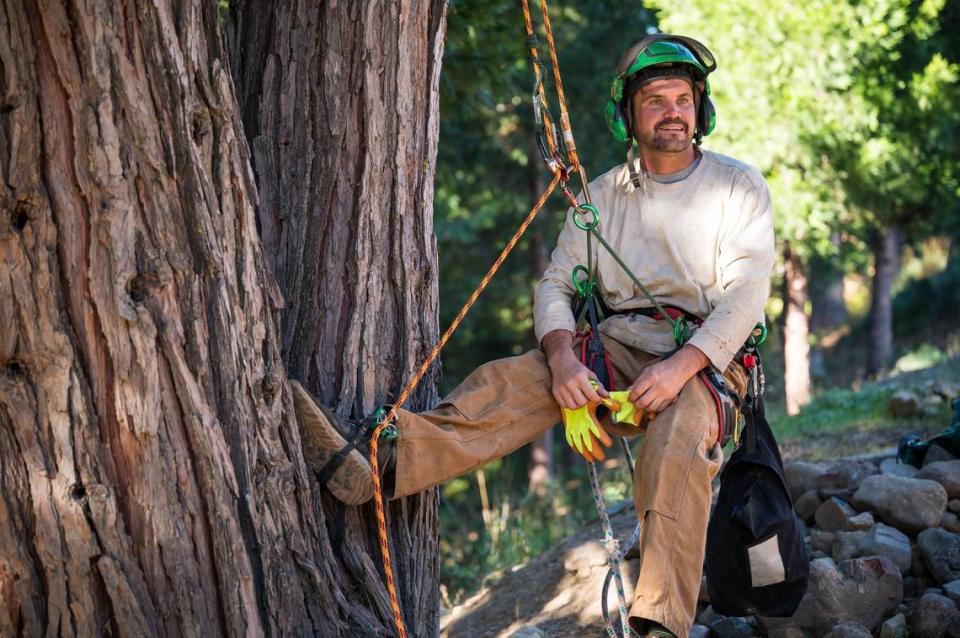
Lemnah was recruited to the job by Rachael Norton, a private licensed forester who specialized in forest thinning before the 2021 Dixie Fire, California’s single largest wildfire, devastated her community. That trauma inspired her to change course and start cone collecting.
Her business called New Growth is staking out a new model. Rather than roaming across state lines for months, she finds trees locally and her team works for a shorter season. Climbers go home at the end of the night.
It’s the type of operation Cal Fire wants to support, and the agency awarded her a business development grant two years ago. During a day of collecting in the backyard of a home in Whitehawk, about 60 miles north of Tahoe City, she said finding climbers has been the “biggest bottleneck to this whole process.”
“It took me more than a year to find some people who were willing to give it a try. Eventually I found these guys through buddies of mine that are rock climbers,” Norton said. “So it’s kind of networking. I was telling everyone, please come climb.”
Hiring is not the only part that’s tricky. Cone collecting is extremely seasonal and unpredictable. The time window to pick cones from trees when they are perfectly ripe can be as short as a week, even days. Collectors are racing against time, squirrels and insects.
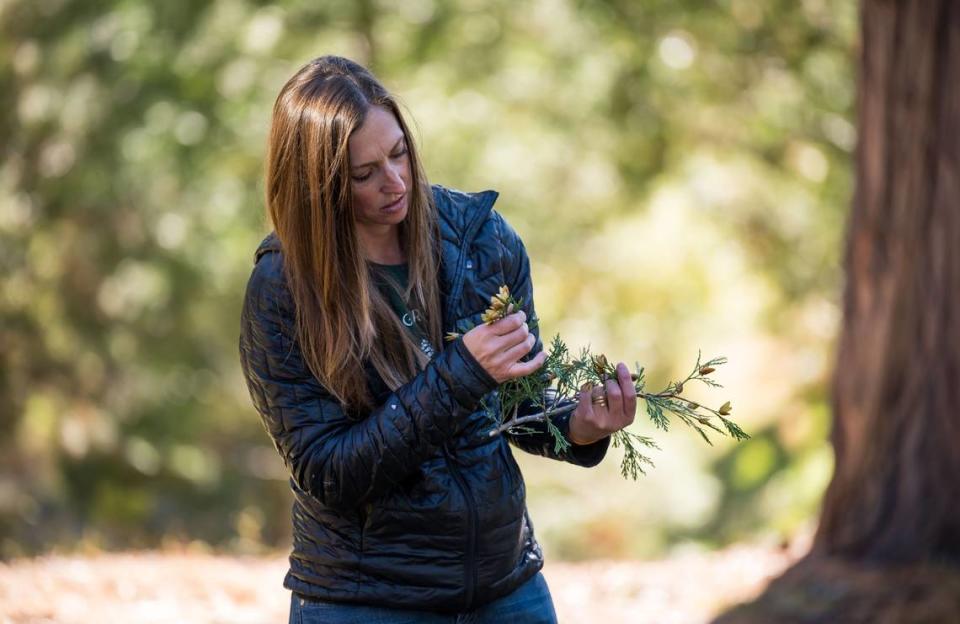
Once cones release their seeds, they float to the ground with little propellers and become impossible to retrieve en masse. That means good trees with ample cones need to be scouted months ahead of time.
Foresters don’t learn about cone collection or reforestation in school, and there isn’t much available science. People have tried drones, potato guns and hunting for squirrel caches, but no method has proven as reliable as climbing.
“We’re in an emergency state with all these mega-fires and the fact that this is going to keep happening. We need new conversations about how we go about cone collection,” Norton said. “To lose entire ecosystems and habitat and watershed areas, I can’t just stand by and watch that happen.”
Without a handbook and very little on the internet, she said she’s making a lot of things up. To check seed health before giving the all-clear to her climbers, Norton jimmy-rigged a cone splitter out of a machete and block of wood.
Then there’s the issue of securing permission to climb, whether on private or public land. The Forest Service owns 58% of California’s forest land, and its system is the most complicated — it even takes a cut of the cones collected. Climbers also must self insure, and many work as independent contractors.
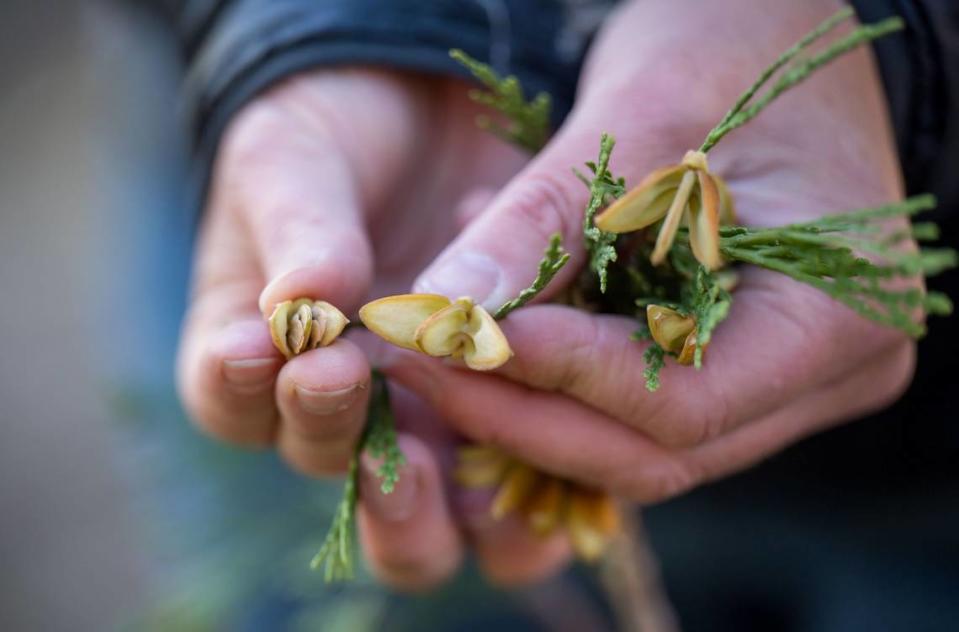
“I get a lot of emails soliciting climbers, but there are just so many requirements,” said Maria Mircheva, executive director of the Sugar Pine Foundation. “Climbers are free-flowing people. They want to be like, ‘Tell me which tree to climb and I’ll climb it.’ You give them a 100-page contract and they’re like, ‘I’m not interested.’”
When it comes to the brass tacks, climbers doing cone collecting typically use a single rope technique. It’s a different method from arborists who climb trees to cut them down or trim them, goal is to be as gentle as possible on the tree and navigate easily through its branches and around the crown, where the cones are.
Usually they will throw or slingshot a rope up and over a strong branch, tying one end to the base of the tree. Out in Plumas, Lemnah climbed his rope with a foot ascender rather than use foot spurs that could damage the bark.
After a couple hours of harvesting, he rappelled down the stand, heavy with bags filled with seed. The cones were measured into bushels, which equal roughly 1 pound. Norton detailed on the bushel bags with genetic information: tree elevation, direction and slope.
Then they’re shipped to the nursery, where they will be dried and processed, then eventually germinated and grown into seedlings. Once saplings are planted in an area that’s a good genetic match, survival rates can range anywhere from 70% to 95%. Hopefully, another round of wildfire won’t kill them.
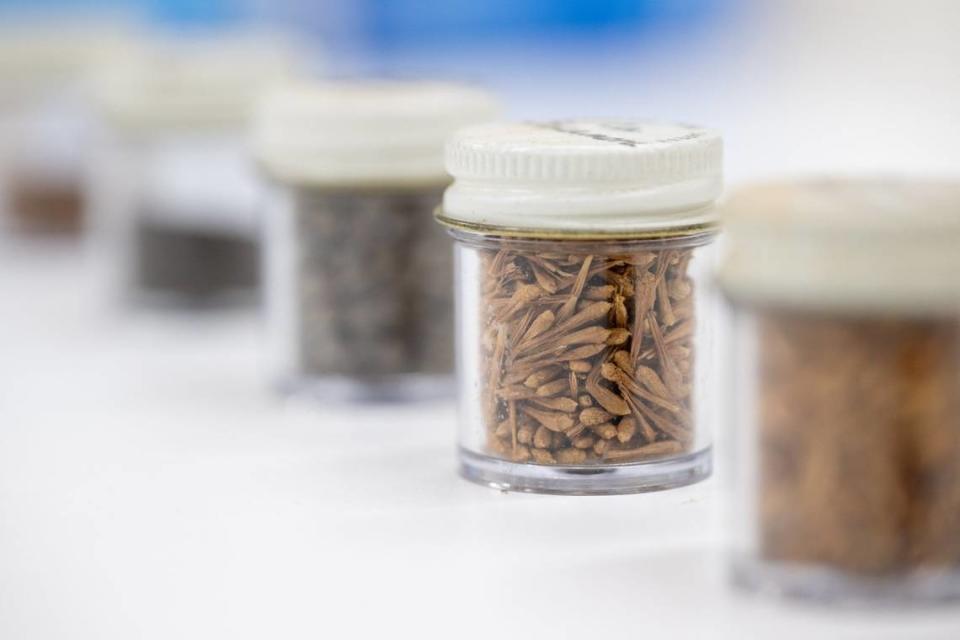
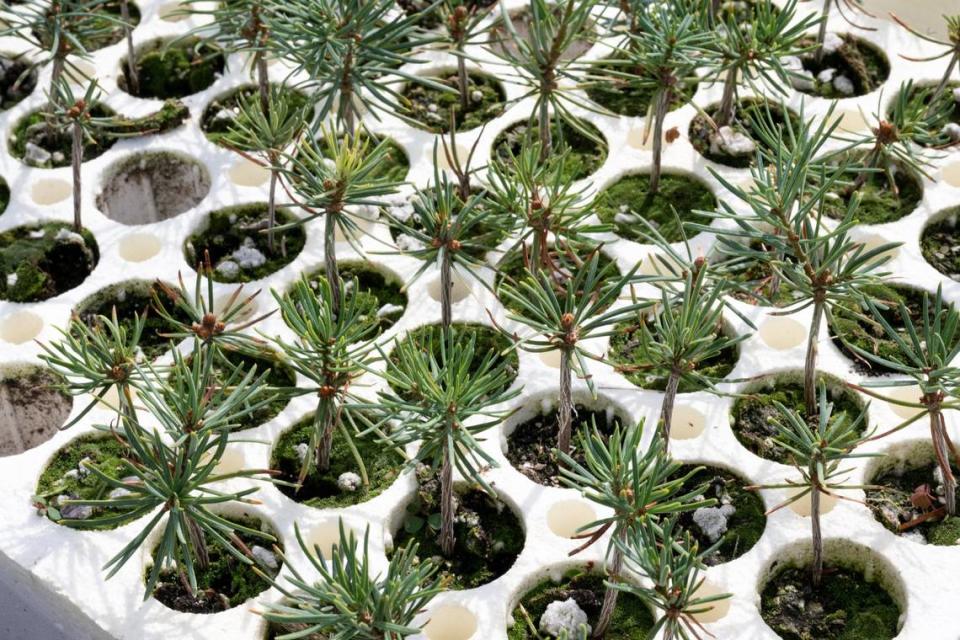
Many cone collectors say they feel part of a larger mission when doing this work. They also appreciate being well compensated — climbing two to three California conifers a day can earn anywhere from $600 to $1,200 for experienced climbers.
“It’s the most rewarding tree work I’ve ever done,” said Ben Cavalier, an arborist who often cone collects in the Lake Tahoe area. He said being in the crown feels like gaining access to a different part of the world, a perspective that most people never get.
“To know that you’re at the very beginning of an assembly line, to get these cones that will produce thousands of seeds, and then people are gonna go plant all these seedlings and then you’re directly responsible for tree planting? It helps you sleep at night.”
Turning seeds into trees
Whether California’s reforestation targets can be accomplished is a valid question. Foresters, environmental restoration advocates, academics, timber executives and nursery owners all say the same thing: There’s simply an extraordinary lack of internal capacity.
California’s more than 30 million acres of forests protect our water supply, sequester carbon, provide habitat for wildlife and offer recreational enjoyment for millions. But parts of it, particularly in low elevations and the Southern Sierra, are disappearing.
The state’s worst wildfires in history coupled with drought have killed hundreds of millions of conifers, or made them susceptible to disease. Research shows that a century of fire suppression, elimination of Indigenous burning and a changing climate are all to blame.
“The worry is that you’re going to see a shift toward loss of conifer ecosystems, and toward shrub-dominated or grassland-dominated ecosystems across the west,” said Solomon Dobrowski, a landscape ecologist at the University of Montana. “California is at the vanguard simply because the amount of fire and how warm it is getting.”
The Newsom task force’s estimate of 1.5 million acres in need of reforestation estimate is likely an understatement. The U.S. Forest Service has estimated that 4 million acres of its land across the nation needs reforestation, mostly due to wildfire. With help from the recent REPLANT Act and Bipartisan Infrastructure Law, the agency invested some $100 million in reforestation last year.
But it wasn’t always like this. At the height of the timber industry, California reforestation was in high demand to replant federally owned forest land that had been clear cut. Then the spotted owl controversy all but collapsed commercial logging in the 1990s.
“The news cameras and the timber companies walked away and left us, the general public, with a lot of land that needs work,” said Steen Christensen, founder of a Humboldt nursery that sells tree seedlings in tubes at National Parks. “Fire suppression exacerbated the problem, and then we ended up with fires and diseases. And so now we have ended up with a lot of acreage that actually does need to be planted.”
Still today, industrial timber companies are California’s biggest and most experienced reforesters. Sierra Pacific Industries alone, which owns 1.8 million acres in the state, produces 15 million seedlings a year. Seed collection is a year round endeavor, and they scout for cones in helicopters.
Cal Fire awarded Sierra Pacific Industries a $3 million grant to help build a new 60-acre nursery in Siskiyou County, where they aim to provide 25 million additional conifer seedlings a year.
Meanwhile, the Lewis A. Moran Reforestation center operated by Cal Fire in Davis closed from budget cuts in 2003. The state’s other nursery in Butte County soon followed in 2010, leaving California with no state-grown forest seedlings.

The Davis center reopened in 2015, but has faced layoffs and retirements that caused a major loss of generational knowledge, said Stewart McMorrow, chief of wildfire resilience at Cal Fire. It hopes eventually to grow 1 million seedlings per year.
“You don’t just turn the lights back on. We need to rebuild everything,” McMorrow said. “And honestly, the timber companies are the real heroes of reforestation because they’re the only ones who know how to do this anymore.”

Meeting the moment
At the state level and among outside groups, an industry-wide mobilization to build up reforestation capacity is underway. After the record 2023 wet season, foresters hope to capitalize on what’s expected to be a bountiful cone production season next year.
American Forests, a national non-profit organization focused on forest restoration, partnered with Cal Fire on a program called the California Cone Corps for the first time last year.
The state worked on a cone collection training this summer with the help of SeGi, a forestry consulting firm started by Steen Christensen. Cal Fire is also developing an internal certification program for state employees to do tree climbing and cone collecting.
“We need to get more eyes to the sky,” said Britta Dyer, vice president at American Forests. “We need new dedicated folks that are working across public and private lands to inform each other. We need to collectively collect because California is in dire need.”
But not all share Dyer’s enthusiasm. With more than 20 climbers on this team, Robert Beauchamp represents the old guard of cone collecting in California. He spent decades amassing knowledge, honing his business and craft.
He agrees there aren’t enough climbers to fill the need, but worries that state and non-profit training sessions simply won’t equip people to climb safely and reliably. The work is too difficult, he said, for someone who isn’t already an arborist or a rock climber.
“It would be great if there were more good climbers out there and quality companies doing climbing operations, not people showing up with ladders,” he said. “I know the state has a program that wants to train climbers. I just think they have no idea what they’re in for.”
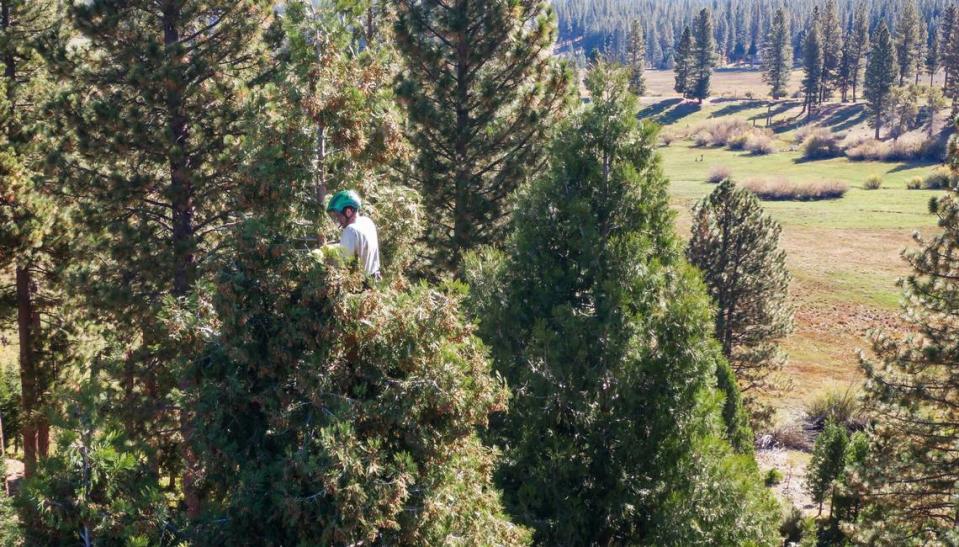
Broadly speaking, a debate also exists about whether forests might fare better without human intervention. Is reforestation the right way to respond to California’s bleak burn scars and make them more resilient?
Tree planting has received criticism as a climate solution, especially if tied to international carbon credits. A company called Mast Reforestation is trying to do just that, on privately owned land in California through the state’s cap-and-trade program.
But most experts agree there is a right way to reforest in severely burned areas, by paying close attention to species diversity and accompanying planting with prescribed burns and fuels reduction. The maximum distance trees can cross pollinate is around 200 feet.
“These fires are burning unnaturally, and I don’t think it’s amiss to think that therefore we would want human intervention to right some wrongs,” said Sarah Campe, regional scientist with the Sierra Nevada Conservancy. “That said, I don’t think reforestation is the only answer.”
Natalie Kim, 24, is getting experience in a variety of potential solutions. She’s a nursery fellow in Davis with the Sierra Nevada Alliance and American Forests. The program is yet another piece of the California forestry world’s effort to attract young people. She said she someday wants to train as a tree climber.
“Wildfires just hang over the state year after year,” she said. “I planted at the King Fire footprint this spring. We’ve got millions of acres to go, but actually putting them in the ground when there’s no living tree for a couple hundred miles feels so worthwhile.“

